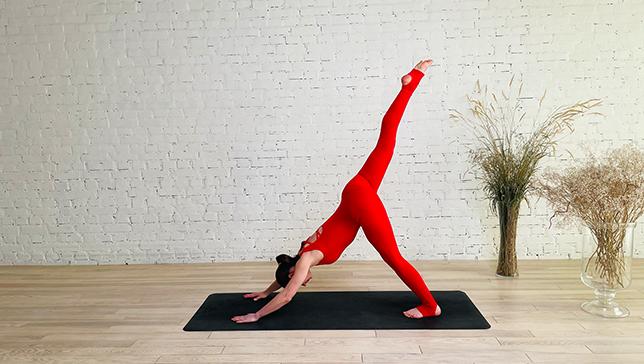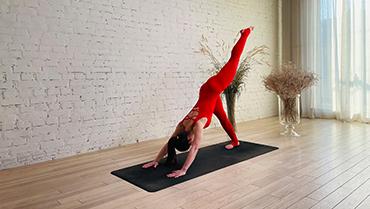One-Legged Downward-Facing Dog Pose - Eka Pada Adho Mukha Svanasana

Contents
One-Legged Downward-Facing Dog Pose or Eka Pada Adho Mukha Svanasana (Eka Pa-da Ah-doh MOO-kuh shvan-AHS-uh-nuh) is a standing inversion that requires balance and flexibility. The name comes from the Sanskrit, eka, meaning “one”; pada, meaning “foot”; adho, meaning “downward”; mukha, meaning “face”; svana, meaning “dog”; and asana, meaning “pose.”
Also known as Three Legged Downward Facing Dog Pose or Tri Pada Adho Mukha Svanasana.
Eka Pada Adho Mukha Svanasana – requires stretch in the shoulders and wrists and increases flexibility in the hamstrings.
Pose Detail
- Body Position: Arm & Leg Support, Forward Bend Yoga Poses, Inversion Yoga Poses, Standing Yoga Poses
- By Type: Balancing Yoga Poses, Flexibility Yoga Poses, Strengthening Yoga Poses
- Difficulty: Intermediate
- By Benefit: Yoga Poses For Stress Relief, Yoga Poses For Weight Loss
Step-by-Step Instructions
Benefits and Contraindications
Strengthens the arms
Quiets the mind
Stretches the hamstrings and hip flexors
Develops confidence in balance
It gives a good stretch to the spine, the quadriceps and the leg muscles. relieves pain in upper and lower back
Relieves pain in upper and lower back
Carpal tunnel syndrome
Eye or inner ear infections
Late-term pregnancy
High blood pressure
Back, arms, or shoulders injuries
Photo poses in different angles

Modifications, Props and Tips
- Keep the lifted leg bent: If you find it challenging to straighten your lifted leg, you can keep the knee bent and focus on maintaining proper alignment in the rest of the body.
- Use a block under the lifted hand: If you have trouble reaching the ground with your lifted hand, you can place a block under your hand to bring the floor closer to you. This modification can help you maintain proper alignment in the shoulders and prevent strain in the wrist.
- Use a wall for support: If you have trouble with balance in this pose, you can practice with your feet against a wall for support. Start with your feet about a foot away from the wall and gradually move them closer as you gain more confidence and strength in the pose.
- Keep the lifted leg on the ground: If lifting your leg off the ground is too challenging, you can keep the foot on the ground and focus on maintaining proper alignment in the rest of the body. This modification can help you build strength and stability in the legs.
Frequently Asked Questions
Yes, beginners can do this pose, but they may need to modify it by using blocks or props for support. It’s important to work within your own range of motion and not push too far beyond your limits.
If you have any injuries or medical conditions that affect your hips, lower back, or hamstrings, it’s important to talk to your doctor or a qualified yoga instructor before attempting this pose. You should also avoid this pose if you have any pain or discomfort in your wrists, shoulders, or neck. Always work within your own range of motion and listen to your body.
Variations
- Downward Facing Dog Pose
- Revolved Downward-Facing Dog Pose
- Downward Facing Dog Pose with bent knees